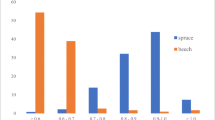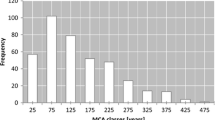Abstract
The shape of the diameter distribution is one of the important elements characterising forest stand structure. In this work we present the application of the method of moments for the estimation of the parameters of a 2-parameter Weibull function. Due to its properties, this function is often used for the description of the diameter distribution in forestry. The work analyses the properties of the Weibull function and its application to a data set representing natural (virgin forest Babia hora) and managed forests (Litschau and Forest School Enterprise of Technical University Zvolen). The parameters of the Weibull function are simply and reliably estimated from the basic stand variables, namely the mean diameter and the coefficient of variation of the diameters. The method is general and does not require specific parameterisation, e.g. for the individual tree species. The work also presents a new algorithm for the estimation of parameters in cases, where tree diameters are measured from a certain minimum recording limit. Based on this study, we suggest using the Weibull function in forest stands only for uni-modal diameter distribution with a mean diameter above 7 cm.





Similar content being viewed by others
References
Al-Fawzan MA (2000) Methods for estimating the parameters of the Weibull distribution. InterStat, statistics on the Internet. Online in Internet: URL:http://www.ip.statjournals.net:2002/InterStat/ARTICLES/2000/abstracts/O00001.html-ssi [Cited 2006-03-10]
Bailey RL, Dell TR (1973) Quantifying diameter distributions with the Weibull function. For Sci 19:97–104
Biging GS, Robards TA, Van Deusen PC, Turnblom EC (1994) The predictive models and procedures used in the Forest Stand Generator (STAG), Hilgardia
Burk TE, Newberry JD (1984) A simple algorithm for moment-based recovery of Weibull distribution parameters. For Sci 30:329–332
Clutter JL, Belcher DM (1978) Yield of site prepared slash pine plantations in the lower coast plain of Georgia and Florida. In: Fries J, Burkhart H, Max T (eds) Growth models for long term forecasting of timber yields. School of Forest and Wildlife Resources, VPI and State University. Publ. No. FWS-1-78, pp 53–70
Ek AR, Issos JN, Bailey RL (1975) Solving for Weibull diameter distribution parameters to obtain specified mean diameters. For Sci 21:290–292
von Gadow K (1984) Die Erfassung von Durchmesserverteilungen in gleichaltrigen Kiefernbeständen. Forstw Cbl 103:360–374
Gerold D (1988) Beschreibung der Durchmesserstruktur und ihrer Entwicklung mit Hilfe der Weibullverteilung. Wissenschaftliche Zeitschrift der Technischen Universität Dresden 37(6):221–224
Gömöry D (1988) Influence of management on the genetic structure of the populations of Norway spruce (Picea abies Karst.) in Slovakia. PhD Thesis. Faculty of Forestry, Technical University Zvolen
Hasenauer H (1994) Ein Einzelbaumwachstumssimulator für ungleichaltrige Fichten-Kiefer- und Buchen-Fichtenmischbestände. Forstl. Schriftenreihe Univ. f. Bodenkultur. 8. Öster. Ges. F. Waldökosystemforschung und experimentelle Baumforschung an der Univ. f. Bodenkultur, Wien
Johann K (1982) Der “A-Wert”—ein objektiver Parameter zur Bestimmung der Freistellungsstärke von Zentralbäumen. Deutscher Verband Forstlicher Forschungsanstalten, Sektion Ertragskunde. Weibersbrunn, pp 146–158
Kangas A, Maltamo M (2000) Performance of percentile based diameter distribution prediction and Weibull method in independent data sets. Silva Fenn 34(4):381–398
Korpel’ Š (1989) Virgin forests of Slovakia. Veda, Slovenská Akadémia Vied, Bratislava (in Slovak)
Leak WB (1965) The J-shaped probability distribution. For Sci 11: 405–409
Liocourt F de (1898) De l′aménagement des sapineres. Bull Soc Forest Franche-Comté et Belfort 4:396–409
Little SN (1983) Weibull diameter distributions for mixed stands of western conifers. Can J For Res 13:85–88
Maltamo M, Kangas A, Uuttera J, Torniainen T, Saramäki J (2000) Comparison of percentile based prediction methods and the Weibull distribution in describing the diameter distribution of heterogeneous Scots pine stands. For Ecol Manage 133(3):263–274
Merganič J, Vorčák J, Merganičová K, Ďurský J, Miková A, Škvarenina J, Tucek J, Mindáš J (2003) Diversity monitoring of mountain forests in the North Orava region. EFRA, Tvrdošín. Online in Internet: URL: http://www.efra.sk/projekty.php (in Slovak) [Cited 2006-03-10]
Meyer HA (1952) Structure, growth, and drain in balanced uneven-aged forests. J For 50:85–92
Miner CL, Walters NR, Belli ML (1988) A guide to the TWIGS program for the North Central United States. Gen Tech Rep NC-125. U.S. Department of Agriculture, Forest Service, North Central Forest Experiment Station, St. Paul
Nagel J (1995) BWERT: programm zur Bestandesbewertung und zur Prognose der Bestandesentwicklung. DFFA, Sektion Ertragskunde, Jahrestagung Joachimsthal, pp 184–198
Nagel J, Biging GS (1995) Schätzung der Weibullfunktion zur Generierung von Durchmesserverteilungen. Allg Forst-uJ-Ztg 166(9–10):185–189
Nanang DM (1998) Suitability of the Normal, Log-normal and Weibull distributions for fitting diameter distributions of neem plantations in Northern Ghana. For Ecol Manage 103(1):1–7
Pommerening A (2000) Methoden zur Reproduktion und Fortschreibung einzelner konzentrischer Probekreise von Betriebs- und Landeswaldinventuren. Forstarchiv 71(5):190–199
Pretzsch H (1992) Konzeption und Konstruktion von Wuchsmodellen für Rein- und Mischbestände. Forstl Forschungsberichte München, pp 115–358
Pretzsch H (1993) Analyse und Reproduktion räumlicher Bestandesstrukturen - Versuche mit dem Strukturgenerator STRUGEN. Schriften aus der Forstlichen Fakultät der Universität Göttingen und der Niedersächsischen Forstlichen Versuchsanstalt, 114, 87 pp
Schiffel A (1904) Wuchsgesetze normaler Fichtenbestände. Mitt Forstl Versuchswesen Österreichs. XXIX
Shifley SR, Lentz E (1985) Quick estimation of the three-parameter Weibull to describe tree size distributions. For Ecol Manage 12:195–203
Shiver BD (1988) Sample sizes and estimation methods for the Weibull distribution for unthinned slash pine plantation diameter distributions. For Sci 34(3):809–814
Šmelko Š (1968) Mathematic—statistic inventory of forest stand volume. Slovenská Akadémia Vied, Bratislava (in Slovak with German summary)
Šmelko Š (1979) Experimental plots for an evaluation of representativeness of forest inventory plots. Zborník prác Lesníckej fakulty VŠLD Zvolen, 21, Bratislava, Príroda, pp 153–182 (in Slovak with German abstract)
Sterba H (1982) Single stem models from inventory data with temporary plots. Mitt Forstl Bundesversuchsanstalt Wien 147:87–102
Sterba H, Moser M, Hasenauer H, Monserud RA (1995) PROGNAUS ein abstandsunabhängiger Waldwachstumssimulator für ungleichaltrige Mischbestände. Deutscher Verband Forstlicher Forschungsanstalten, Sektion Ertragskunde. Eberswald bei Berlin, pp 173–183
Ueno Y, Osawa Y (1987) The applicability of the Weibull and the expanded Weilbull distributions. J Jpn For Soc 69(1):24–28
Van Laar A, Mosandl R (1989) Durchmesserverteilung in jungen Eichenbeständen. Allg Forst-uJ-Ztg 160(9,10):189–194
Weisstein EW (2003) Weibull distribution. From MathWorld—a Wolfram Web Resource. Online in Internet: URL: http://www.mathworld.wolfram.com/WeibullDistribution.html [Cited 2006-03-10]
Wensel LC, Daugherty PJ, Meerschaert WJ (1986) CACTOS user’s guide: the California conifer timber output simulator. Bulletin 1920. Division of Agriculture Science, University of California, Berkeley
Zarnoch SJ, Dell TR (1985) An evaluation of percentile and maximum likelihood estimators of Weibull parameters. For Sci 31(1):260–268
Zutter BR, Oderwald RG, Murphy PA, Farrar RMJr (1986) Characterizing diameter distributions with modified data types and forms of the Weibull distribution. For Sci 32(1):37–48
Acknowledgements
This work was carried out during the research stay of J. Merganič at the BOKU University of Natural Resources and Applied Life Sciences in Vienna, financed by ÖAD during 2002–2003. We are very grateful to Prof. Šmelko for providing us with the data from permanent inventory plots of FSE TU Zvolen for the presented analyses. We also thank Robert Williams and two anonymous reviewers for their comments, which helped us to improve the quality of the presented paper.
Author information
Authors and Affiliations
Corresponding author
Additional information
Communicated by Hans Pretzsch
Rights and permissions
About this article
Cite this article
Merganič, J., Sterba, H. Characterisation of diameter distribution using the Weibull function: method of moments. Eur J Forest Res 125, 427–439 (2006). https://doi.org/10.1007/s10342-006-0138-2
Received:
Accepted:
Published:
Issue Date:
DOI: https://doi.org/10.1007/s10342-006-0138-2




